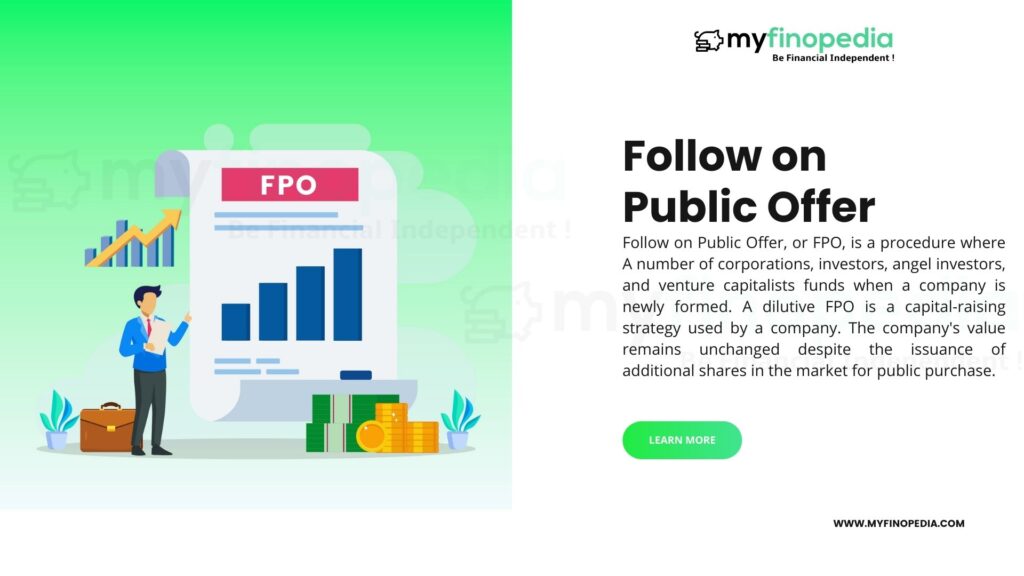The two of fundamental concepts that aspiring stock investors should understand prior to starting their stock market investments are IPO and FPO. FPO is the stock, as opposed to IPO, that investors offer after the initial public offering made to the general public to broaden the company’s equity after the shares of a company in which shares are sold to shareholders.
In this section, we will examine the various aspects of these two stock investment components in order to gain a better stock market exposure.
What FPO means?
Follow on Public Offer, or FPO, is a procedure where A number of corporations, investors, angel investors, and venture capitalists funds when a company is newly formed. But, when the company reaches a larger stage of growth and these funds run out or are insufficient, it will launch an IPO, become publicly traded for the first time, and be listed on exchanges. To be on the spot, the FPO will issue of additional shares by a company next to the initial public offering intended to existing shareholders or capitalists to create more equity of the company at the same time to reduce debt.
By the time more recent shares are created and subsequently sold by the company, the total number of outstanding shares rises, diluting earnings per share. For the long-term objectives of the company and its shareholders, the cash inflow from the sale is typically strategic and viewed favorably.
There are two main categories of FPOs: Dilutive and Non-dilutive.
A dilutive FPO is a capital-raising strategy used by a company. The company’s value remains unchanged despite the issuance of additional shares in the market for public purchase. Companies must be aware of the potential long-term effects of dilutive FPOs on investors, such as lower earnings per share and diluted voting rights. Dilutive FPOs should be used when the company has no other practical options. Dilutionary FPOs may also be detrimental to the company’s standing with investors. Due to this, businesses should exercise caution when pursuing dilutive FPOs and consider alternative strategies. Diluted FPOs should only be used if the company has no other practical options.
Non-dilutive follow-on public offerings take place when insiders (such as venture capitalists) or company directors looking to diversify their holdings offer to sell privately held shares. This method, apart from a diluted IPO, does not change the number of shares issued by the company.
When exchange-listed companies sell freshly issued shares into the secondary trading market through a designated broker-dealer at current market prices in order to raise capital, this is referred to as a follow-on public offering (FPO), also known as an At-the-market offering (ATM) or controlled equity distribution.
How does an FPO work?
Using a follow-on public offering, a business can raise money for future ventures and expansion plans. Initial Public Offering (IPO) refers to the first time a company makes its equity available to the public, however that, Follow-on Public Offer refers to the process a company uses to raise additional capital after an IPO after a period of time (FPO).
If a company wants to increase the public shareholding in the business, one of the main justifications for having a Non-diluted FPO is that. A higher public shareholding encourages greater public involvement, which improves price discovery for the shares. For these reasons, investing in an FPO is less risky than doing so in an IPO. An FPO application process resembles an IPO application process. Orders are placed through your broker in this manner.
A Few Illustrations on FPO
Many companies have raised capital through FPOs after an IPO. In a recent example, the Adani Enterprises (AEL) disclosed its decision to forego the fully subscribed Follow-On Public Offer (FPO). AEL claimed that by returning the FPO proceeds, it was defending the interests of its investor base in light of the unprecedented circumstance and the current market volatility.
What is the difference between IPO and FPO?
IPO and FPO are contrasted with one another using a variety of parameters in the sections that follow:-
- A follow-on Public offering (FPO) is when a business issues extra shares to potential investors or current shareholders after an IPO in order to increase equity or lower debt. In contrast to IPO, when a company reaches a more advanced stage of growth and these funds exhaust or are insufficient, it will initiate an IPO.
- An IPO’s price can either be fixed or variable as a range, whereas an FPO’s price is market-driven and based on the number of shares.
- Depending on the type of FPO it is, an IPO’s share count may alter, either going up or down. The share capital increases in a non-dilutive FPO and decreases in a proceeding-through-the-listing FPO because the company decides to issue new capital to the public for its listing.
- FPOs are less expensive because the value of the company listing its shares is further diminished, whereas IPOs are frequently more expensive to execute.
- An FPO is issued by an already listed company, whereas an IPO is issued by an unlisted company.
- FPO are less risky than IPOs because investors are more informed about potential future outcomes in FPO because the company is already publicly traded.
The next step will be determined by your risk tolerance and goals. An FPO is typically a safer bet for inexperienced and individual investors. An IPO investment requires more research than an FPO because you must first understand the fundamentals of the company. But if you are a long-term investor with a healthy appetite for risk and confidence in the company, you should consider investing in an IPO. Despite the fact that risk and returns do correlate, risk and returns play a significant role in the differences between FPO and IPO.






